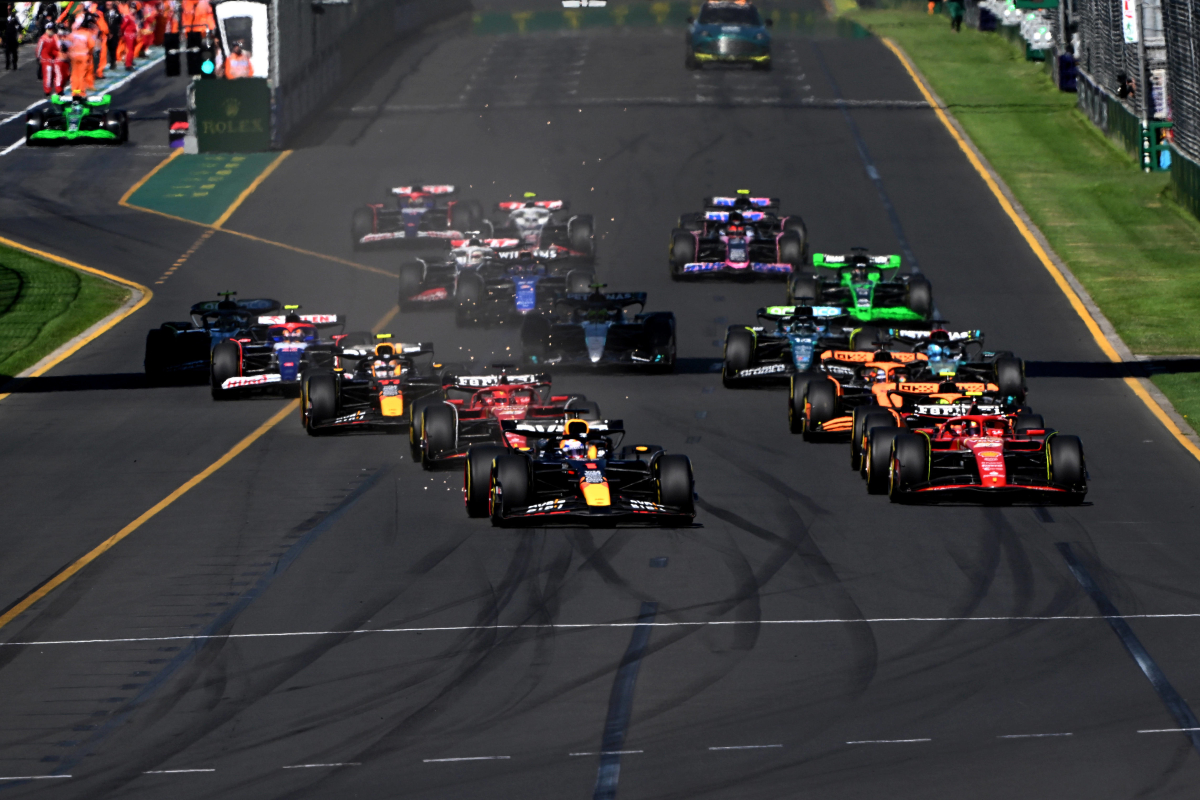
F1 pit stop strategy breakdown: The undercut and overcut explained
F1 pit stop strategy breakdown: The undercut and overcut explained

Learn how the undercut and overcut strategies work in Formula 1 and how they can make or break a race for drivers and teams.
Strategies in F1 play a vital role in determining the outcome of a race, and pit stops are a key battleground. Teams constantly analyse tyre wear, track conditions, and rival tactics to decide when and how to bring their drivers in for fresh rubber.
READ MORE: US F1 star signs MEGA new contract
And for those unfamiliar, pit stops involve bringing the car into the pits for new tyres and other necessary adjustments. Fresh tyres offer better grip, allowing drivers to push harder and achieve faster lap times. But pit stops take time, and the strategic battle lies in figuring out when to pit and which tactic - undercut or overcut - to employ.
Now, get ready to dive into the world of F1 pit stop strategies.
Undercut in F1
Let's start with the most common tactic - the undercut. This is an aggressive strategy when a driver pits before their rivals in front to gain an advantage over them. The team meticulously analyse factors like tyre wear on the leading car and make calculations before making the call.
So, how does it work? Well, imagine two cars, 'Driver A' and 'Driver B', battling it out for P1. Driver A decides to pit first, sacrificing precious track time for a brand-new set of tyres. While they lose some time during the pitstop, they emerge with significantly faster rubber. Driver B, on the other hand, is out on track on older, worn tyres.
Here's what happens next. Driver A's out-lap (the first lap after emerging from the pitlane) on fresh tyres will be considerably quicker than Driver B's in-lap on worn tyres. This allows Driver A to reduce the time gap and propel them ahead of Driver B by the time the latter exits the pit after completing the pit stop.
This tactic is used on high-degradation circuits and circuits where overtaking is hard. One good example is the 2019 Singapore Grand Prix, when Sebastian Vettel perfectly executed an undercut from P3.
Ferrari pitted Vettel early for fresh tyres. The new rubber allowed the German to set a good out-lap time, significantly faster than the slower in-laps of Leclerc and Hamilton on older tyres. By the time Leclerc emerged from the pits, Vettel had snatched the lead, ultimately securing his last win in his F1 career.
Of course, the undercut isn't a guaranteed path to glory for the trailing driver. A slow pitstop, getting stuck in traffic during the pitlane window, or an unexpected safety car can all ruin the undercut strategy, as well as if the driver fails to set faster lap times and make up for the time lost during the pit stop.
Also, if the leader (Driver B) noticed the undercut attempt, they could counter by pitting earlier than expected or pushing harder to extend their lead and stay out of the undercut window altogether.
However, a flawlessly executed undercut, with perfect timing and a clean pit stop, can turn a chasing driver into a race leader in a matter of laps.
READ MORE: OUTRAGEOUS Las Vegas GP ticket prices revealed
Overcut in F1
An overcut strategy takes the opposite approach. Here, Driver A stays out on track for longer than Driver B, aiming to maintain a good pace even on older tyres. The gamble is that Driver B, after pitting for fresh rubber, might struggle to get those tyres up to operating temperature quickly. This initial slowness on the out-lap after the pit stop could allow Driver A to extend their lead and maintain position even after their own eventual pit stop.
Also, Driver A will have the chance to further extend their lead due to the clean air, which provides optimal aerodynamic performance due to not having a car in front.
Overcut is less popular than undercut, and it is used on tracks with low tyre degradation and where it's nearly impossible to overtake, just like in Monaco.
At the 2021 Monaco Grand Prix, Hamilton attempted an undercut on Pierre Gasly but struggled to get heat into his new tyres, resulting in slower lap times compared to Gasly on used tyres. This allowed Gasly to extend his lead and maintain his position after his pit stop.
Sebastian Vettel, however, stayed out even longer than Gasly and Hamilton, and with well-managed tyres, emerged ahead of both after his pit stop.
So, the next time you see a driver pit early or late during a grand prix, remember the strategic chess match of undercuts and overcuts that can make or break a race.
READ MORE: Hamilton's Mercedes commitment discussed by team-mate amid Ferrari switch
Related
Change your timezone:
Latest News

Red Bull respond to Newey departure leak
- 59 minutes ago

Verstappen JUMPS ahead of Hamilton in incredible statistic
- 1 uur geleden

Baffled F1 pundit asks if Ferrari are 'joking' after MAJOR Miami GP decision
- 2 uur geleden

Marko explains why Perez no longer compares himself to Verstappen: 'He gave that up'
- 3 uur geleden

Brundle delivers SCATHING assessment of proposed point system changes
- Yesterday 21:00

Vettel set to miss out on Mercedes seat as two clear candidates emerge
- Yesterday 20:00

Brundle delivers SCATHING assessment of proposed point system changes

Get to know Kimi Antonelli: The junior sensation who could be set to replace Hamilton

Major F1 rules shakeup 'postponed' amid fan backlash

Lewis Hamilton's mystery new assistant: Who is Charlotte Davies?
F1 Standings

Drivers
- Oliver Bearman
- Charles Leclerc
- Carlos Sainz
- Lando Norris
- Oscar Piastri
- Pierre Gasly
- Esteban Ocon
- Sergio Pérez
- Max Verstappen
- Alexander Albon
- Logan Sargeant
- Lewis Hamilton
- George Russell
- Nico Hülkenberg
- Kevin Magnussen
- Fernando Alonso
- Lance Stroll
- Valtteri Bottas
- Zhou Guanyu
- Daniel Ricciardo
- Yuki Tsunoda
Races
-
 Gulf Air Grand Prix of Bahrain 2024
Gulf Air Grand Prix of Bahrain 2024
-
 Saudi Arabian Grand Prix 2024
Saudi Arabian Grand Prix 2024
-
 Grand Prix of Australia 2024
Grand Prix of Australia 2024
-
 MSC Cruises Grand Prix of Japan 2024
MSC Cruises Grand Prix of Japan 2024
-
 Grand Prix of China 2024
Grand Prix of China 2024
-
 Miami Grand Prix 2024
Miami Grand Prix 2024
-
 Gran Premio dell'Emilia Romagna 2024
Gran Premio dell'Emilia Romagna 2024
-
 Grand Prix of Monaco 2024
Grand Prix of Monaco 2024
-
 Grand Prix du Canada 2024
Grand Prix du Canada 2024
-
 Gran Premio de España 2024
Gran Premio de España 2024
-
 Grand Prix of Austria 2024
Grand Prix of Austria 2024
-
 Grand Prix of Great Britain 2024
Grand Prix of Great Britain 2024
-
 Grand Prix of Hungary 2024
Grand Prix of Hungary 2024
-
 Grand Prix of Belgium 2024
Grand Prix of Belgium 2024
-
 Heineken Dutch Grand Prix 2024
Heineken Dutch Grand Prix 2024
-
 Grand Prix of Italy 2024
Grand Prix of Italy 2024
-
 Grand Prix of Azerbaijan 2024
Grand Prix of Azerbaijan 2024
-
 Grand Prix of Singapore 2024
Grand Prix of Singapore 2024
-
 Grand Prix of the United States 2024
Grand Prix of the United States 2024
-
 Gran Premio de la Ciudad de Mexico 2024
Gran Premio de la Ciudad de Mexico 2024
-
 Grande Prêmio de São Paulo 2024
Grande Prêmio de São Paulo 2024
-
 Heineken Silver Las Vegas Grand Prix 2024
Heineken Silver Las Vegas Grand Prix 2024
-
 Qatar Grand Prix 2024
Qatar Grand Prix 2024
-
 Grand Prix of Abu Dhabi 2024
Grand Prix of Abu Dhabi 2024
About GPFans
GPFans is a multi-platform, multi-language brand dedicated to Formula One coverage. We bring you all the ins and outs of the sport, 24/7, everything from up-to-the-minute news and features to the latest viral stories and clips.We believe that a new generation of exciting, outspoken drivers will make F1 more popular than ever before, and we want to give our users access to as much of their heroes as possible, on and off the track. From Lewis Hamilton to Max Verstappen, Daniel Ricciardo to Sebastian Vettel, we provide in-depth analysis of every every Grand Prix in the season, from Australia to Abu Dhabi.
With Formula One under the new ownership of Liberty Media, how the sport is being covered is evolving, and GPFans will look to be at the heart of this progression into new media, as one of the fastest-growing sites covering the king of motorsports.
Follow us on your favorite social media channel
Corporate & Media
 Innovatieweg 20C
Innovatieweg 20C7007 CD, Doetinchem, Netherlands
+31645516860
Realtimes | Publishing Network
Copyright (©) 2017 - 2024 GPFans.com
Realtimes | Publishing Network













 Gulf Air Grand Prix of Bahrain 2024
Gulf Air Grand Prix of Bahrain 2024  Saudi Arabian Grand Prix 2024
Saudi Arabian Grand Prix 2024  Grand Prix of Australia 2024
Grand Prix of Australia 2024  MSC Cruises Grand Prix of Japan 2024
MSC Cruises Grand Prix of Japan 2024  Grand Prix of China 2024
Grand Prix of China 2024  Gran Premio dell'Emilia Romagna 2024
Gran Premio dell'Emilia Romagna 2024  Grand Prix of Monaco 2024
Grand Prix of Monaco 2024  Grand Prix du Canada 2024
Grand Prix du Canada 2024  Gran Premio de España 2024
Gran Premio de España 2024  Grand Prix of Austria 2024
Grand Prix of Austria 2024  Grand Prix of Hungary 2024
Grand Prix of Hungary 2024  Grand Prix of Belgium 2024
Grand Prix of Belgium 2024  Grand Prix of Azerbaijan 2024
Grand Prix of Azerbaijan 2024  Grand Prix of Singapore 2024
Grand Prix of Singapore 2024  Gran Premio de la Ciudad de Mexico 2024
Gran Premio de la Ciudad de Mexico 2024  Grande Prêmio de São Paulo 2024
Grande Prêmio de São Paulo 2024  Qatar Grand Prix 2024
Qatar Grand Prix 2024  Grand Prix of Abu Dhabi 2024
Grand Prix of Abu Dhabi 2024